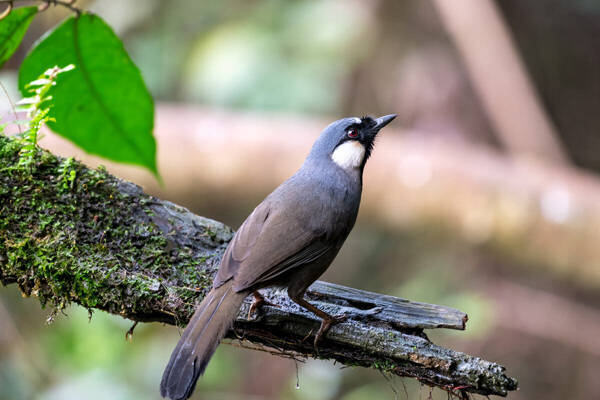Pterorhinus chinensis
IUCN
LCBasic Information
Scientific classification
- name:Pterorhinus chinensis
- Scientific Name:Garrulax chinensis,Pterorhinus chinensis,Black-throated Laughingthrush,,Dryonastes chinensisBlack-throated Laughing Thrush, Mountain Bird, Coral Bird
- Outline:Songbird
- Family:Passeriformes Thrushidae Laughingthrush
Vital signs
- length:22-29cm
- Weight:80-99g
- lifetime:About 10 years
Feature
The forehead, front of the eyes, around the eyes, chin and throat are black, with a white spot on the black forehead
Distribution and Habitat
Distributed in Cambodia, Lao People's Democratic Republic, Myanmar, Thailand, Vietnam, China (western and southern Yunnan, Guangxi, Hong Kong and southern Guangxi).
It mainly inhabits evergreen broad-leaved forests, tropical monsoon forests and bamboo forests in low mountains and hilly areas below 1,500 meters above sea level. It is sometimes seen moving and foraging in secondary forests and shrubs near farmland, villages and coastal areas. It inhabits dense bamboo forests and dense thickets in semi-evergreen forests.
Appearance
The plumage of male and female black-throated thrush is similar. The forehead, front of the eye, around the eye, cheeks, chin and throat are generally velvety black. There is a white spot immediately above the black spot at the forehead, followed by gray-blue from the top of the head to the back of the neck, and a large white spot behind the outer eye (except the Hainan subspecies). The sides of the neck are olive gray or brown. The back, shoulders and other upper body of the nominate subspecies are olive gray with green, the Yunnan subspecies is olive brown with brown, the Hainan subspecies has a brown back neck to the upper back, and the rest of the upper body is olive brown; the wing coverts are the same color as the back, the flight feathers are dark brown, the outer vanes of the outer flight feathers are gray or silver-gray, and the inner flight feathers are the same color as the back. The tail is dark olive brown or olive gray brown with black terminal spots. The black terminal s
Details
Black-throated Laughingthrush, also known as Black-throated Laughingthrush, has 5 subspecies.

Black-throated Laughingthrush is a resident bird. It often moves in small groups of several or more than 10 individuals, and occasionally it is seen moving alone or in pairs. They often jump around in the bushes under the forest. Individuals in the group keep in touch through calls. They have strong social behavior. When they are dispersed, they quickly gather together through calls. If one bird in the flock is injured, the other birds will not flee immediately. If the injured bird is caught and screams, other birds seem to come to rescue it. They make frequent calls during activities, which are pleasant to the ears. In addition to jumping on low branches of trees and shrubs, they often jump quickly on the ground, flapping their wings and nodding their heads. After jumping for a while, they will start to sing vigorously again, especially in the morning, evening and early spring. This activity is more frequent. If they find people or are suddenly disturbed, they sometimes fly away. Their flight is clumsy and laborious, and they usually fall down after flying a short distance.
The black-throated thrush mainly feeds on insects such as ants, stink bugs, beetles, weevils, and walking beetles, and also eats some plant fruits and seeds.
The call of the black-throated laughingthrush is loud, clear, mellow and pleasant, and its sound is like "di bu-, di bu-". The black-throated laughingthrush is commonly known as the "mountain call bird" because of its loud and pleasant call, and is often raised as an ornamental bird.
The breeding season of the black-throated laughingthrush on Hainan Island is from March to August. It breeds two nests a year, the first nest is usually from March to June, and the second nest is from July to August. It nests in dense bushes or bamboo forests under the forest, and the nest is generally not high from the ground. The nest is shallow cup-shaped, mainly composed of grass roots, leaves, vines, etc., with tender grass roots inside, and the structure is relatively loose. The size of the nest is 16 cm in outer diameter, 8.1 cm in inner diameter, 8.2 cm in height, and 5.4 cm in depth. Each nest lays 3-5 eggs, usually 4 eggs, white eggs, 28.8 mm × 20.4 mm in size.
The population of the Black-throated Laughingthrush is relatively abundant in China. It is one of the famous caged birds. The government and environmentalists advocate that hunting should be controlled and attention should be paid to protection.
Listed in the "Red List of Endangered Species of the World Conservation Union" (IUCN) 2016 ver 3.1-Least Concern (LC).
Listed in the "List of Terrestrial Wildlife with Important Economic and Scientific Research Value under State Protection" (item 480) issued by the State Forestry Administration of China on August 1, 2000.
Listed in China's "National Key Protected Wildlife List" (February 5, 2021) Level 2.
Protect wildlife and eliminate game.
Maintaining ecological balance is everyone's responsibility!








